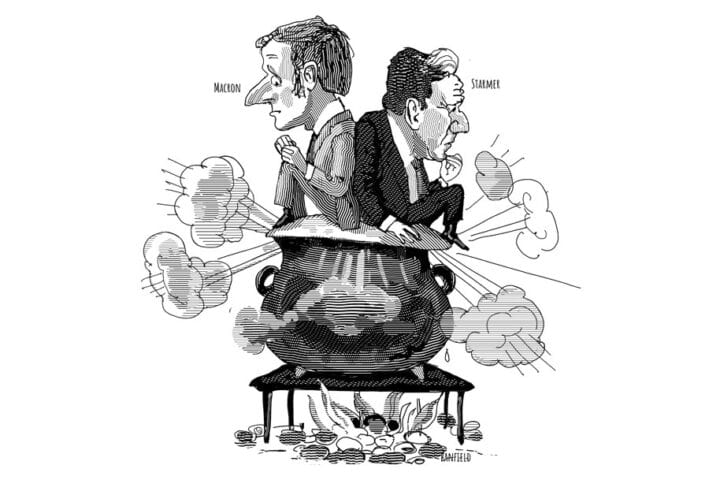Books Reviewed
The late James Q. Wilson once observed of a domestic reform proposal that, like Middle East peace, it had everything in its favor except feasibility. It’s hard to avoid this conclusion about the reforms proposed by Philip K. Howard.
Howard sees an America mired in frustration and dysfunction. As he says at the outset of his new book, Everyday Freedom:
Nothing much works as it should. Simple daily choices seem fraught with peril. In the workplace, we walk on eggshells. Big projects—say, modernizing infrastructure—get stalled in years of review. Endemic social problems such as homelessness become, well, more endemic.
As a lawyer, Howard focuses his diagnosis on the legal system. Everything seems to risk lawsuits, which in turn generate demand for detailed rules and regulations from bureaucrats, which smother initiative and undermine trust. “The cure,” he maintains, “is not mainly new policies, but new legal operating structures that re-empower Americans in their everyday choices.” Howard would like to discard legalism in favor of confident reliance on sound judgment: “Liberty in the broad sense requires judges and officials, when applying legal principles, to assert norms of reasonableness. Otherwise, self-interested people will use law to claim almost anything.”
***
He’s been making similar arguments for some time, as the author of the bestselling The Death of Common Sense (1995) and a follow-up, Try Common Sense (2019), as well as The Collapse of the Common Good (2002) and Life Without Lawyers (2009). Somehow his message doesn’t seem to be gaining ground.
One reason, surely, is that terms like “common sense,” “common good,” and “norms of reasonableness” no longer seem capable of carrying the weight Howard wants to place on them. Environmental advocates resist “reasonable” compromises over building new highways or commercial developments, partly from fear that promised safeguards on such projects won’t be maintained over time.
And it’s not only a pattern on the left. Advocates for gun control measures have learned to characterize their proposals for restricting sale of firearms as “common sense safety regulation.” So advocates for gun rights tend to resist such measures—and bring lawsuits against them—because they fear that such “reasonable” measures will be unreasonably applied in practice by government officials they expect will prove hostile toward all private gun ownership.
It is natural that interest groups demand tighter standards, whether from courts or regulators, to protect their own priorities. In our litigious society, however, these priorities often include maintaining the advocacy groups’ own future bargaining leverage—something distinct from, sometimes even at odds with, achieving their favored policy outcomes.
Take the example of schools—an example Howard offers, when he laments that we have entangled classrooms with petty rules, rather than trusting teachers to make sensible decisions and trusting principals to hold them to account. But empowering better teachers and ambitious principals, as Howard recommends, would provoke resistance from teachers unions, which have gained formidable political influence in state legislatures and city councils, and in the U.S. Department of Education.
Environmental advocacy groups want more charging stations for electric cars and more solar or wind-turbine generation of electricity. But they have resisted relaxing environmental review procedures to speed approval of such projects, lest such procedures come to be more widely adopted and undermine their own capacity to demand more searching “environmental impact statements” for other new projects.
Successful advocacy groups win sympathy—or at least inhibit opposition—with broadly appealing slogans. Environmental advocates present themselves as fighting for “clean air” or “clean water” or, more grandiosely, for “saving the planet from climate change.” So too with civil rights and feminist groups urging we take action to assure “equity” and “inclusion.” At a high enough level of abstraction, no one is against these aims—except those who are greedy, heedless, bigoted, or otherwise deserve to be opposed and condemned. Advocacy groups often see themselves not just maneuvering for policy advances but participating in redemptive social struggles.
***
Howard is aware that judges and regulators respond to wider political trends. He attributes the distortions of the legal system to the political passion and turbulence of the 1960s, which prompted legal scholars and then judges to urge closer federal control of private commerce and local government, and then closer judicial supervision of federal regulators.
But the legal trends that took hold in the 1970s were not inspired by demands to “Crush Common Sense!” or “Defeat the Common Good!” To the contrary, they were inspired by the hope (naïve as it now appears) that with courts pressing agencies to prove they had taken a “hard look” at policy alternatives or had adopted “due process” procedures to assure a “voice” to all affected interests, public policy would be more rational, evidence-based, and balanced.
Howard’s challenge is that his competing slogans don’t seem to summon quite as much enthusiasm as “Save the planet!” or “Resist racism!” Everyday Freedom is a brief pep talk for his outlook, which relies heavily on inspirational quotations from classic writers (Alexis de Tocqueville, Max Weber, Hannah Arendt) and more recent observations by journalists and social scientists. Their admonitions remind us of the need to trust personal choice, informal networks, experienced judgment, often good advice. Still, these are not battle cries, but more like conclusions to a sermon, inviting nodding worshippers to say, “Amen.” What everyone approves—in the abstract—is not what anyone feels stirred to go out and fight for.
When it comes to particulars, there is much less agreement. You can see the problem when you look at the most prominent counter-thrusts against the judicial activism of the 1960s and ’70s. “Textualism” and “originalism” called for interpreting statutes and constitutional provisions by the meaning of their words or the meaning understood at the time of adoption. Advocates claim these approaches afford more reliable or objective grounds for decisions. But to that extent, they reflect distrust that judges can decide based on what’s “reasonable” or in accord with “the common good.” Conservative judges and commentators have not been confident they could persuade others to accept opinions presented as determinations of “reason” or “common sense.”
But this approach has not soothed opponents. Opinion leaders have disdained calls for trust, even when it comes to judges. Donald Trump provoked much indignation when calling out judges who ruled against him as “Democrat judges,” but leftist columnists now deride unfavorable Supreme Court decisions as the work of “MAGA justices.” It’s not at all likely that partisan mobilization and distrust will be resolved by better judges or judges adopting different methods. Political debate and policy maneuvering have become at the same time more intensely partisan but also more unfocused and chaotic.
***
In a book published in 1937, The Road to Wigan Pier, George Orwell lamented the crackpot causes fluttering alongside the organized Left: “One sometimes gets the impression that the mere words ‘Socialism’ and ‘Communism’ draw towards them with magnetic force every fruit-juice drinker, nudist, sandal-wearer, sex-maniac, Quaker, ‘Nature Cure’ quack, pacifist, and feminist in England.” When the Labour Party came to power in 1945, it still kept a relentless focus on economic policies it thought would appeal to its working-class constituents.
Today’s cranks not only find their counterparts across the vast jangle of voices on the internet, they then somehow manage to stake kinship claims on seemingly unrelated causes. The process displayed its full absurdist potential over the past year with Hamas solidarity rallies featuring groups proclaiming themselves “Queers for Palestine.” Meanwhile, seemingly anodyne causes like “parental rights” or “religious freedom” now provoke immediate resistance from the Left, as threats to their own pet projects (such as “gender identity affirmation”) or as interfering slogans from the opposing camp.
Successive federal administrations have not looked to defend moderate middle-ground positions, as energized “progressives” battle on every front against the mobilized battalions of self-described “patriots.” The Biden Education Department and Department of Health and Human Services have positioned themselves as an advance guard in disputes about transgender rights, while the Energy Department and Environmental Protection Agency seek to limit production of gas-powered vehicles. President Trump promises opposite priorities. More and more policy disputes seem to revert to an irreconcilable choice between voices calling us “Forward!” and those urging “Go Back!”
***
I don’t have more practical advice to offer than Howard. There is some consolation from the thought that wars don’t go on forever, not even “culture wars.” Relentless combat is exhausting. The Left’s most crackpot impulses may be losing steam—replacing police with social workers, abandoning fossil fuels for energy from soft breezes and sparkling sunbeams, denying biological sex differences while harping on politically defined racial divides. A few electoral rebukes may make Democratic Party leaders see more virtue in moderation or what Howard calls “common sense.” A less provocative Left could help soothe today’s angry Right.
But common sense is not what you get just by restraining courts or legal doctrines. It is akin to patience and a sense of proportion, hard to maintain when people are enraged (or despondent). Like other virtues, it can be seen as a mean between extremes—here, between fanaticism and fatalism (or between stridency and senility). We might get more of it if opinion leaders practiced talking more calmly.
We should hope that someday—perhaps in the post-Trump era—the country reaches a stage at which Philip Howard’s appeals can be taken more to heart. Without something like “reason” as a marker, there are no bounds to the reach of coercion through law.




